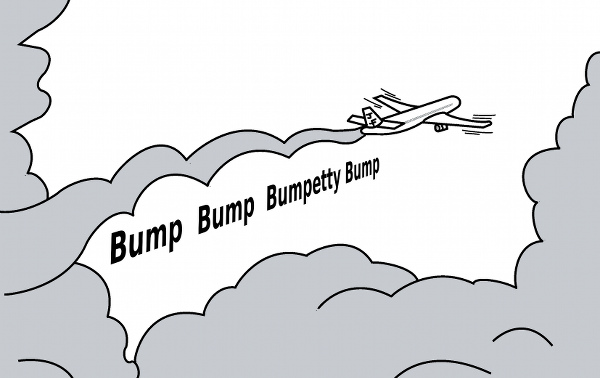It probably comes as no surprise that turbulence is the single most common thing that disturbs anxious flyers. I thought it might be helpful to run through a discussion about “the dreaded turb”. There is a fair bit to talk about, so I’m going to break it down over a few posts. Today we shall paint the problem with a broad brush; later we’ll get into some Turbulence crannies and fill in the detail.
Firstly, let’s deal with the elephant in the room… There is no such thing as an air pocket! The airplane will not plummet thousands of feet, despite what the hysterical media tell you from time to time. Good… now we’ve got that out of the way, let us continue out discussion…
Here’s a few other random observations about Turbulence and our interpretation of it, just to get the conversation started…
- An airplane is like a dart… The “feathers” on a dart ensure that the thing always flies “point first”, even if it is thrown a little wobbly. The relationship between the centre of gravity of the dart and the feather surfaces produce a natural stability that makes this the only way a dart can behave when thrown through the air. An airplane is no different! It is going to keep going in the direction it is pointed, and a few bumps will not change that.

- Modern airliners are ridiculously strong! They will not break. They are designed to be strong but flexible, and can handle any turbulence they are likely to encounter.
- The air is always in motion, to some extent. In my opinion it is better to assume that you will encounter at least SOME turbulence on any flight. Sometimes people HOPE for a smooth flight and dread the turbulence… then their experience of that flight is dependent on whether or not they encountered any turbulence. And some flights ARE smooth… but most will have at least a few bumps.
- What causes turbulence? I have included a lengthy discussion on common causes of Turbulence in the book “Dragons of Thin Air”, so I’ll refer you to that. See chapter 10…

I know Turb is not dangerous… so WHY does it bother me?
We can get sensitised to the thing that troubles us such that we overrate any such events, particularly if we have had a bad experience in the past. Reducing this sensitivity is achievable but requires a little work… a combination of knowledge about the topic, but also of our own responses as humans.
 Anxiety/Fear/Panic is an interesting phenomenon… and learning skills to control anxiety so that it does not escalate is really valuable. Stopping the “tension tornado”, as the Dragon book describes. For example, various relaxation and breathing control techniques seem to be effective. This is simply about reducing your own tendency to escalate your emotional state into high anxiety unnecessarily. This escalation is, to some extent, wired into us but (the good news…) it can be worked with and tamed.
Anxiety/Fear/Panic is an interesting phenomenon… and learning skills to control anxiety so that it does not escalate is really valuable. Stopping the “tension tornado”, as the Dragon book describes. For example, various relaxation and breathing control techniques seem to be effective. This is simply about reducing your own tendency to escalate your emotional state into high anxiety unnecessarily. This escalation is, to some extent, wired into us but (the good news…) it can be worked with and tamed.
This is not about tricking yourself into believing something you really don’t… it is more about keeping yourself in an emotional state where you can think rationally (not the emotional state of high anxiety!). Then you will be better able to realistically assess the environment around you, rather than amplify the importance of things that trigger your anxiety… like turbulence!
For some, the process of tackling Fear of Flying is not so much about learning to trust the airplane, or to trust the air, or to trust the maintenance engineers… but learning to trust yourself again. It isn’t really about the turbulence… it is about your fear of your response to the turbulence.
This is particularly the case if a person has experienced a “panic attack” in the past and is afraid of it happening again (and perhaps not really understanding why it happened in the first place).
 A gradual re-developing of a relationship with flying, in small steps and with some education, plus help in learning about your own emotional makeup and responses can help. You can learn that the thing which you thought was a demon was nothing more than a fictitious dragon in a cheap suit!
A gradual re-developing of a relationship with flying, in small steps and with some education, plus help in learning about your own emotional makeup and responses can help. You can learn that the thing which you thought was a demon was nothing more than a fictitious dragon in a cheap suit!
Some of the people on the Taking Flight forum have taken videos of their flights, and some find help in gradual desensitisation by watching such videos. Here’s one, if you feel up to it. It has a patch of LIGHT turbulence in it. Some nice parts of it are seeing the wings bouncing up and down a little (the flexibility I mentioned), and a very cool experiment where they filmed a cup of water while in turbulence… the water doesn’t even spill! This is confirmation that often our interpretation of turbulence far exceeds it’s actual severity.
(Note: sometimes in videos the bumps look worse than they really are because it is hard to hold a camera steady, and the movements are accentuated. Observe the movement of the people and other objects for a better appreciation of the bumps).
In my next post on Turbulence I’ll take you through what your pilots are thinking about and doing during turbulence. No, despite popular opinion, they are NOT reading the newspaper or doing a crossword… 😉

